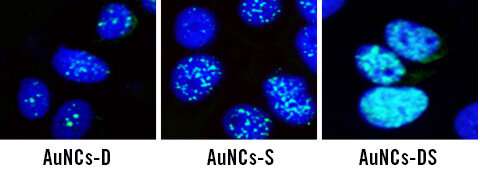Increase of the genomic DNA damage (pale blue) mediated by bifunctional (DS) gold nanoclusters (AuNCs) in cancer stem cells. Credit: Alvaro Somoza
Chemotherapy is one of the most used treatments against cancer, along with surgery and radiotherapy. In a chemotherapy treatment, one or several drugs are administered to the patient to remove or damage cancer cells. Nevertheless, the treatment has several drawbacks that are hard to overcome, particularly the side effects. In this case, the inherent toxicity of the drugs employed causes a variety of symptoms including weakness, nausea and hair loss. As a result, chemotherapy is far from an ideal approach.
In this regard, scientists are trying to improve the efficacy and specificity of chemotherapy using carriers to deliver the drugs only where they are needed. Carriers based on gold nanostructures are excellent candidates for this objective because of their excellent stability, absence of toxicity and ease of modification with several chemical agents. Furthermore, some gold nanostructures, such as nanoclusters, are fluorescent, allowing their use for biotracking and imaging purposes.
The group of NanoBiotechnology at IMDEA Nanociencia, led by Prof. Álvaro Somoza, has used gold nanoclusters coated with albumin to facilitate the attachment of two active molecules for the treatment of breast cancer. They used doxorubicin (D), a chemotherapeutic agent that intercalates in the DNA causing cell death, and camptothecin analog SN38 (S), a potent topoisomerase I inhibitor. The modified nanostructures were tested in vitro against breast cancer cells, where the release of chemotherapeutics took place in a controlled manner. Remarkably, the nanotherapy was able to reduce the size and number of mammospheres, a cancer stem cell model. This type of cell presents higher resistance to chemotherapy and is responsible for relapses and chemoresistance. What is more, the system combining both drugs presented excellent antitumor activity in different cancer models, thus confirming its promising nanotherapeutic potential.
This is the first time that albumin-stabilized gold nanoclusters have been used to deliver more than one drug, with excellent antitumoral activity, in cancer and cancer stem cells. "Our bifunctional nanostructure could be an excellent solution to overcome the solubility and biodistribution problems of different drugs," Somoza says. These nanomaterials could be the basis of a Trojan-horse strategy to get the chemotherapeutics effectively inside the tumors. The gold nanoclusters act as the vehicles for carrying the drugs where is needed and release them upon internal stimuli. Whereas chemotherapy research is developing new drugs for cancer treatment, emerging nanotherapies are about building smart vehicles for existing drugs, reducing costs and improving the efficiency of the treatments.
More information: Á. Latorre et al. Multifunctional Albumin-Stabilized Gold Nanoclusters for the Reduction of Cancer Stem Cells, Cancers (2019). DOI: 10.3390/cancers11070969
Provided by IMDEA Nanociencia






















